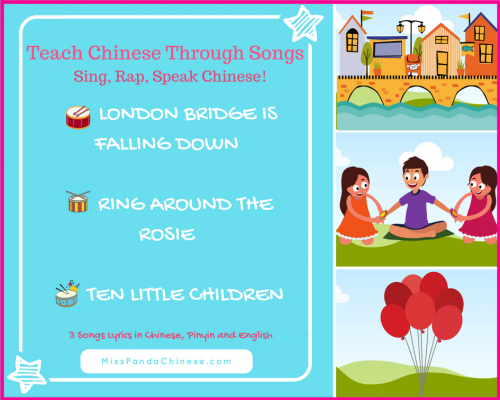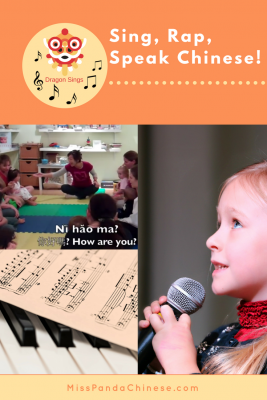Teach Chinese Through Songs: Sing, Rap, Speak Chinese! Teaching Children Chinese Language with Songs and Movement.
Music is the movement of sound to reach the soul for the education of its virtue. -Plato
Singing is a joyful way of learning and an effective way to teach languages to children of all ages. Teach Chinese through songs is a playful experience for children and adults. As I repeatedly stress the importance of setting up a target language print-rich or text-rich home environment as parents introduce Chinese to children or teach Chinese to kids I also want to bringing music to the Chinese language and culture learning journey. You will also enjoy introduce Chinese to Children through Ni Hao and Number Songs.
Teach Chinese through songs and music is to create a music-rich environment for young learners. Creating a music-rich experience for children with singing, listening, and moving is highly important. These experiences provide great benefits to children as they move on to formal learning environment, according to Mary Luehrisen, executive director of the National Association of Music Merchants Foundation (NAMM), a non-profit organization that promotes the benefits of music.
Singing is always a joyful way of learning. It is also an effective way to teach languages to children and adults. Teach Chinese through songs to young children with nursery rhymes and daily routine songs. For older children, Chinese classic songs and Chinese music videos of pop songs or current greatest hits are excellent tools to use as authentic materials to teach Chinese vocabulary, expressions and detect culture similarities and differences.
Back in my pre-mommy days I taught Chinese children and adults English (ESL) for all levels in Taiwan. Later, I taught English to young learners (Pre-K to Grade 2) at Rabat American School in Morocco. When my own children were born I was determined to teach them my other language – Chinese. In their early years we sang Chinese nursery songs together and played games while humming and chanting. I also used English-language children’s songs pre-translated into Chinese.
Then I started to translate more songs and nursery rhymes into Chinese, creating my own versions in order to add the language learning elements I wanted to focus on in the songs. At the same time, with the lack of playful and entertaining Chinese children’s songs and resources I began to create my own funny and silly songs to help my children to follow the daily routines, such as getting to the car, using polite words, counting, taking a shower, a bedtime lullaby…etc.
I wrote all the lyrics and created almost all the tunes and music. The giggling from my two children supplied me with inspiration. It has been a top-rated and best-selling audio album for teaching Chinese to young children on Amazon, iTunes, and Google Play since its release. The English-Chinese bilingual approach and Comprehensible Input style I have used in this audio CD/MP3 have helped thousands of parents and educators to start the journey of introducing Mandarin Chinese to young children in a playful way.
A big thank you goes to my parents who provided me the opportunity to learn piano. However, I was not a typical diligent Chinese student. I was a hyperactive child and I could hardly sit still for ten minutes. It seemed rare to see a child like me in the Chinese culture many years ago, but I was… It is another story itself and I can tell you more about it later.
You and I, we all want children to learn. For me, as a parent and an educator, I want to make sure that children feel the joy of learning from the resources and environment I have created for them. Joy of Learning can help kids to keep learning, to be curious, to explore in languages, world culture, and beyond even when they are no longer under our wings.
Let’s get back to my adventure of teaching Chinese to little kids.

With the concern of the increasing input of the community language, that is English, for my daughter at school, I knew that I needed to support the input of her heritage language, Mandarin Chinese outside of home environment. Therefore, I designed a playful Chinese program for her class. I brought this Chinese program to her and taught all the four-year-olds in a group setting. The twist here is that my daughter was the “Little Teacher” during this weekly class. She enjoyed it very much. More importantly, she was not the only one speaking Chinese. Her whole class including her room teacher was learning, singing, and playing in Mandarin Chinese! If you want to know how to create a similar program comment at the end of this article and let me know.
What were the best methods or approach I found and used to teach young children a foreign language, English or Chinese? Singing and movement as well as hands-on activities.
We know that young children have amazing learning abilities. When children are having fun they learn almost effortlessly. This applies to older kids and adults as well. In the Miss Panda Chinese programs, children sing and do movements with songs and raps. Kids and parents dance and march with the beats. We also laugh about how silly some of the movements and lyrics are.
There are plenty of song repetition and a lot of action involved. Repetition is a key for young learners. Repeated actions and movements help them to stay focused and lengthen their attention spans.
When I conduct my parent-child programs I always start the program with my “Hello!” and “Counting!” songs and wrap up each session with my “Goodbye!” song. These class routines serve as cues to let the children know when it is time to start the class and when we are done with today’s language learning fun.
During the Chinese immersion sessions we sing and dance, do our “kung fu” moves, try a craft and read a story. I select the songs according to a weekly theme. For example if we have an animal theme, we might sing the classic “Ugly Little Duckling” and “Two Tigers” songs. I also have plenty of fun toys on hand. The children will sing the songs, see my plush animal friends, pat them and give them hugs. Singing and movement maximize the use of the senses to reinforce the language learning experience.
Below are three action-filled English children’s songs that I translated into Chinese to assist you to get your teaching started. I have made some changes to the songs so they make sense in Chinese. They are interactive songs for parent/child playtime at home or in a playgroup setting at school.
If you are new to teaching language to young children you will find the following resources helpful: Teaching Early Language Learners and 6 Tips for Teaching Language to Kids on Language Latte.
Are you ready to try “London Bridge” in Mandarin Chinese with your little one(s)?
Have fun! – 玩得開心 | 玩得开心 – Wán de kāi xīn!
London Bridge – Lún Dūn Tiě Qiáo (video above)
Movement Tip: Place your child on your knees and drop/raise your knees gently according to the lyrics. I replaced “my fair lady” part with “Qīn ài de bǎo bèi” (‘my dear precious one”) to make it relevant and rhythmic in Chinese. You can replace the last part of the phrase “bǎo bèi” (“precious one”) with your child’s name to personalize the song. I have added the “tickles” at the end not only to teach that phrase but also to raise the enjoyment level higher (parents and teachers also love to hear the happy laughter of the little ones!)
Lún dūn tiě qiáo dǎo xià lái London Bridge is falling down,
Dǎo xià lái falling down,
Dǎo xià lái falling down.
Lún dūn tiě qiáo dǎo xià lái London Bridge is falling down,
Qīn ài de bǎo bèi Dear precious one.
Sāo yǎng sāo yǎng sāo yǎng Tickle, tickle, tickle!
倫敦鐵橋 倒下來, 倒下來, 倒下來
倫敦鐵橋 倒下來, 親愛的寶貝,
搔癢, 搔癢, 搔癢
Ring Around the Rosie – Zhuǎn Quān Quān
Movement Tip: Hold hands with your child/ren. Form a circle if you have several kids in the group. Walk in a circle and sing this song. When you sing to “Wǒ men dōu dié dǎo “ everyone pretends to fall down on the mat. I use a play parachute when we sing this song. The children love to fall into the parachute at the end.
Zhuǎn ya zhuàn quān quān ya turning and going in circle
Zhuǎn ya zhuàn quān quān ya turning and going in circle
Zhuǎn ya zhuǎn ya turning and turning
Wǒ men dōu dié dǎo we all fall down
轉呀 轉圈圈呀 轉呀 轉圈圈呀
轉呀 轉呀 我們都跌倒
— simplified Chinese version follows.
转呀 转圈圈呀 转呀 转圈圈呀
转呀 转呀 我们都跌倒
===
Movement Tip: Stomp your feet or clap your hands according to the beat. Point to the subject you are indicating in the song. I have replaced the “Indians” with “little children.” I also replace “little children” with “toys (wán jù),” “dolls (yáng wá wa), ” and “balls (qiú)” according to what we are counting. At the end, I add the action word “jump (tiào)!” so the children say the word and jump up and down.
Yī gè liǎng gè sān gè xiǎo péng yǒu one two three little children
Sì gè wǔ gè liù gè xiǎo péng yǒu four five six little children
Qī gè bā gè jiǔ gè xiǎo péng yǒu seven eight nine little chldren
Shí gè xiǎo péng yǒu ten little children
Tiào tiào tiào! jump jump jump!
一個兩個三個小朋友
四個五個六個小朋友
七個八個九個小朋友
十個小朋友
跳 跳 跳
— simplified Chinese version follows.
Love to read more Chinese teaching resources from Miss Panda? Sign Up for Email Updates:
This post first published on Tiny Tapping Toes. -2018 update-
Exploring More in Teach Chinese Through Songs Series
11 Chinese Songs and Nursery Rhymes for Kids
Eensy Weensy Spider
Lion King Hakuna Matata
Sing, Rap, Speak Chinese!
I Miss You So Much

Hi
Awesome
Hello, can you help me start a Miss Panda Chinese Program in my town? I live in Rapid City, South Dakota with my three young children. We have almost zero Chinese language resources here, but a few families may be interested in learning Mandarin with us!
I will be glad to help you with my online program. Please use the contact form or email me at info(at)misspandachinese(dot)com